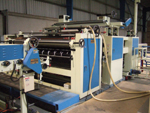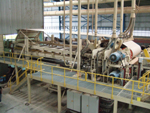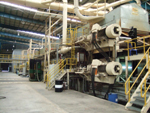A lot to sell
10 February 2009The Metro-Ply group of companies is one of the oldest players in the field of panel production in Thailand.It started out as a teak sawmill, going into plywood production in 1973, followed by entry into veneer production, wet process hardboard, doors and finger-jointed hardwood.Indeed, the company is still active in all those areas but it was in 1995 – a time of considerable activity in SE Asia for composite panel production lines – that the company entered the MDF business.
That first line was from Sunds and had a Küsters continuous press which was initially 17m long but two years later was extended to 23m. This subsidiary is known as Metro MDF Co Ltd. It was built on a 102,000m2 site at Karnchanaburi on the Meklong river, about two hours’ drive from Bangkok.
In 2000, Metro Fibre Co Ltd was born as a new subsidiary on the same site, boasting another Sunds (later known as Metso Panelboard of course) line with 17m Küsters press. Although designed with extension in mind, this press remains at its original length.
The combined annual capacity of these two lines is around 230,000m3.
On the same site, the hardboard line turns out 80 tons/day by the wet-process system.
Five years later, Metro decided to add particleboard to its range of panels and was thus able to be a one-stop-shop for its customers, offering MDF, hardboard and particleboard from the one group of companies.
Metro Particle Co Ltd was established in a different location, but an existing Metro site, at Nonthaburi, 60km from Bangkok. This location would give the mill ready access to urban waste wood from the metropolis, if required.
Siempelkamp was chosen as the supplier for this project, which is equipped with a 30.4m ContiRoll continuous press. In 2005, the new press was only 23.8m long, but once again Metro had planned ahead when constructing the foundations and just one year after the first board was produced, the press was extended to 30.4m. Capacity of this line today is around 1,100m3/day, or 375,000m3/year.
The company returned to Karnchanaburi for its third and latest MDF project, although it is not on the same site as the other two MDF lines but nearby, across the river. This 15ha site was formerly waste land beside the river and had to be extensively piled before construction work could begin.
At the time of our last visit, in late 2006 (WBPI Issue 1, 2007, p39), the buildings were mainly roofed, the continuous press was half-constructed and machinery continued to arrive on low-loader trucks from the docks in large crates.
The whole site looked very different on my return in late November 2008. Buildings were complete, concreted yards laid, and MDF was being produced at full speed.
Metro again chose the press used for the first and second MDF lines, although at the time of the contract, Metso Panelboard was the supplier and it was called a Contipress.
Today, the press business of Metso is owned by Siempelkamp, which has taken on the responsibility for the existing lines and contracts.
The Advance Fibre Co Ltd Contipress is 28.28m long and once again the company has allowed for possible future expansion by laying foundations of 40m. The line produces around 750m3 a day, depending on thickness produced of course.
“We plan to extend the press to 40m at the end of 2009 and this is fairly fixed,said Mr Niphon Udomsinprasert, general manager, who took a major part of the responsibility for seeing this project through. “It is in the original contract for the press and Siempelkamp has assumed responsibility for this. That should take us to production of 1,200-1,400m3/day.”
Mr Finn Basse Rasmussen, production process specialist with Advance Fibre Co, has considerable experience of panel production lines worldwide – and of the market forces they must face.
“The economic crisis is hitting now,he said in November, “and we are focused very, very strongly on production costs because the sales price is under pressure worldwide. However, it is not as bad here in Asia as it is in western Europe it seems – the Asian furniture market is not too bad and the standard of living is still rising, a bit.”
The wood supply for all the group’s factories is good, being pure eucalyptus, pure rubberwood or a mix of the two for MDF, while the particleboard line is mainly using sawmill residues. Here again, the company separates the wood species. Some small roundwood is also used for particleboard production.
“Rubberwood plantations are increasing in the northeast of Thailand where there are about one million rai (160,000ha) planted with government tax incentives,said Mr Rasmussen.
When it comes to adding value to the panel products, there is one short-cycle melamine press line, one paper lamination line, one direct printing line and a veneer overlay line. Markets are furniture and laminate flooring producers.
MDF line 3 has value-adding facilities which were under commissioning at the time of my visit. They include a paper lamination line by Wang Tai Machinery Co Ltd of Taiwan and a Bürkle of Germany direct printing line.
Advance Fibre’s new line
When designing the factory, Metro was able to start with a blank sheet of paper, so to speak, and the result appears to work.
“This is a very nice layout with a lot of free space, which gives us flexibility,said Mr Rasmussen.
Logs arriving at the debarking line are unloaded by four tower grab cranes mounted above the line. Wood comes from the south and east, and in the locality of the mill, but in future there could be supplies from the huge resources in neighbouring Myanmar.
There are two debarkers with separate infeeds. One is a drum-type, feeding a disc chipper, while the other is a Fuji Kogyo screw debarker, which feeds a drum chipper.
“This again gives us flexibility as any very twisted logs are debarked more effectively in the Fuji,said Mr Rasmussen. “The drum chipper also enables material such as stumps to be chipped.”
Bark from the debarkers goes to the Metso Panelboard energy plant (this business area was also acquired from Metso by Siempelkamp). The energy plant has a grate and a dust burner, while hot gases from the furnace pass over a thermal oil coil and then to convection heaters. Fines from the oscillating wet chip screens also go for energy production.
The wet chip silo has a capacity of 10,000m3, or four days’ production requirement.
The Metso refiner is a 60in unit, which can take 62in segments, and processes 40 tons of fibre per hour at 60in.
“We have not reached that limit yet – all the green end, the refining and the [Imal of Italy] glue area are ready for the 40m press,explained Mr Rasmussen. The factory uses conventional blowline resination.
The dryer tube splits into two branches to go to two separate cyclones, again to cope with the full, extended, capacity of the line.
A double Z-sifter is employed to remove any latex lumps more effectively before the fibre goes on to the dosing bin for the formers, which were the latest Metso forming technology, with independently controlled rollers designed to achieve the best spread for each type of fibre, length-and cross-wise on the line. A GreCon IR3000 moisture meter follows the former. The textile belt pre-press is extra long because it is designed for a production speed of 120m/min and needs to maximise de-aeration of the mat.
After the pre-press and Cassel metal detector there is an Imal press security device (PSD) to offer further protection to the valuable stainless steel belts of the continuous press from lumps or foreign bodies contained in the mat. This is followed by a mat water-mist spray, also by Imal.
The mat dump – in the event that the PSD does detect a problem – operates at a maximum speed of only 60m/min so it is preceded by a faster cutting device for the higher production speeds to avoid the mat ‘jumping the gap’.
“I have always worked with the Küsters-type continuous press and I feel it gives much better control of the pressure in both cross-wise and length-wise directions than its competitors. Yes, the chain oil consumption is higher, but in real terms the cost of that per cubic metre of panel produced is negligible. Control of that oil flow is of course important – especially for good belt tracking,said Mr Rasmussen.
A combined GreCon blister detector/thickness gauge comes after the press as the boards move on to the unique star cooler. This is a Metro group design because it wants the panels to rotate through 360o rather than 180o for, it believes, more efficient cooling.
At the end of the line there is a Lukki robotic panel handling system, a Steinemann Satos eight-head sander from Switzerland and an Anthon of Germany angular panel sawing system.
After the sander is an Argos Control surface inspection system for the raw boards. This is capable of detecting latex spots as small as 1mm.
Most production is to E1 and E2 standard, but the company was trialling an “E0.5and E0 panel at the time of WBPI’s visit. Resins for all factories come from the group’s own resin factory.
Metro’s new line has its own extensive laboratory, equipped with a climate room to meet the exacting JIS (Japanese Industrial Standard) requirements; and perforator and chamber test equipment for measuring formaldehyde emissions from its panel samples. Of course there is also equipment for the normal mechanical tests such internal bond (IB), modulus of elasticity (MoE), surface soundness, etc. All these tests are in addition to the on-the-line quality control measurements and that Argos surface inspection system.
“The laboratory is one of the busiest places on a good MDF line,said Mr Rasmussen. “All our results are logged on the computer and samples are kept. Any complaint there is could be months down the line these days, perhaps from export customers, and our consumers are becoming ever more knowledgeable and quality-conscious.”
These are difficult times for all panel producers, but as of late-2008, the SE Asian producers seemed to be less badly affected than their western counterparts. Most of Metro’s market is in Asia and the Middle East and while demand was down at the time of my visit, a lot of mills were, like Metro, still producing panels on a 24/7 basis.
With total current group MDF capacity of around 580,000m3 a year, particleboard of 440,000m3 and 80 tons/day of hardboard, the Metro-Ply Group certainly has a lot of board to sell.


